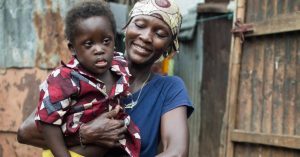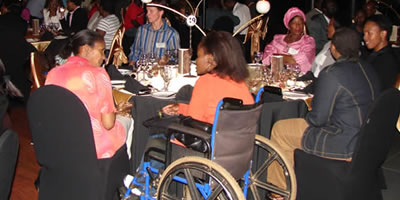Addressing Special Needs in a University Setting
Presentation at 5th Africa Forum, Accra, Ghana
4–8 July 2011
By Voctor Locoro
Email: vlocoro@gmail.com
Department of Community and Disability Studies
Kyambogo University, Uganda
Abstract
This paper examines efforts and challenges in the provision of higher education to persons with visual impairments in Uganda. It draws on the experience of some universities in the country in providing space and opportunity to such persons to study and participate in university activities.
Introduction
For a long time, higher education in Uganda was provided to persons with visual impairments through integrating such persons in teacher education institutions and Makerere University – the oldest university in the country. Those who got opportunity to enroll in these institutions were admitted primarily on grounds of their high academic grades in the high school or equivalent institution. Sad to say, however, no efforts were made by the institutions that enrolled them to modify the physical and learning environments to suit their mobility and learning needs. The individual student with visual impairment was required to fit into and learn to cope with the systems of the institution.
At the establishment of Kyambogo University in 2003, the government mandated the university to develop and promote programmes aimed at fostering inclusive education and training, comprehensive rehabilitation service provision and empowerment of people with disabilities and other special needs at all levels in the country (Government of Uganda, 2003). Since then, Kyambogo University has worked closely with government and civil society stakeholders in the pursuit of this mandate.
In this paper, special needs refer to factors that hinder or restrict the participation, learning and development of an individual in an environment. These factors include health problems, disability, behaviour and communication difficulties etc. Visual impairments encompass the two forms of vision loss i.e. blindness and low vision.
Similarly, inclusion refers to change of attitudes, practices and the physical environment in the home, school/institution and society so that all people (regardless of gender, age, disability or special needs) can have opportunity to actively participate in and contribute to the affairs of their families and communities. It is a practice which promotes respect for and stresses the value of individual differences in society and enhances acceptance of individuals with such differences. It enables persons with disabilities and other special needs to have freedom to interact, learn, play, communicate, experience the feeling of belonging, grow and develop in accordance with their potentials. It calls for active involvement of persons with special needs in all aspects of life in the home, school/institution and society.
Coping with higher education demands
While enrolment at university or tertiary institution was, and perhaps still is a sign of career success for many students with visual impairments in Uganda, coping with the demands and expectations of studies at such levels has not only been difficult, but also stressful for many of them. For instance, although students with visual impairments who enrolled in Makerere University in the last three decades received Sighted Guide assistance, the university did not provide the specialized equipment and materials the students required e.g. perkins barillers and Braille paper (both of which were not obtainable in the country until recently), typewriters or laptop computers, cassette recorders and cassette tapes. Instead, these students were given limited funds to purchase these requirements on their own. On the other hand, the students who enrolled in tertiary institutions did not receive this support from their institutions. They relied on occasional support from non-governmental organization such as Uganda Society for Disabled Children and the Uganda National Association of the Blind.
The unfriendly physical and learning facilities in both universities and tertiary institutions in the country has restricted the active participation of students with visual impairments in those institutions for a long time. This arises from the fact that:
- implementation of relevant policies and legislation is not vigorous;
- there is limited funding for programmes that provide for the needs of persons with disabilities and other special needs at various levels;
- inclusion of disability issues in institutional policies and planning is still limited;
- use of technology to facilitate the learning of students with visual impairments is still limited;
- awareness on needs of persons with disabilities and other special needs is still limited in institutions of higher learning;
- there is limited trained human resource in relevant specialized service areas to guide institutions;
- there is limited provision of assistive devices and specialised materials to students in higher education.
However, as a result of the nationwide advocacy by Disability Movement stakeholders in the country and internationally, as well as the increasing recognition of the social model of disability and the human rights-based approach to service provision, a number of legislation, policies and programmes have been put in place by government to promote access, equity and quality of education and training for all at all levels. The role of Kyambogo University here stands out as training personnel to foster inclusive education and training, comprehensive rehabilitation service provision and empowerment of people with disabilities and other special needs at all levels.
Benefits of inclusion
The figure below highlights some benefits of inclusion:
Strategies of realizing inclusion in a university setting
- Staff Preparation
Preparation of staff is crucial and should be planned for all levels. It involves training and re-training to enable the staff:
- acquire knowledge and skills on how to support students and colleagues with disabilities special needs;
- appreciate the entitlements and potentials of students and colleagues with special needs;
- appreciate that all people can learn and work and that all of them need some support for that purpose;
- make deliberate efforts to identify and assess the needs of students with special needs and take up appropriate interventions;
- engage in collaborative planning and consulting one another;
- appreciate dealing with individual differences and needs;
- adapt a new attitude, behaviour and ways of working with the students and staff with special needs;
- enhance partnership with the families of students special needs as well as other relevant stakeholders.
Kyambogo University embarked on this staff preparation in a phased manner in order to serve as a model to other universities in the country.
- Student Preparation
Both the ordinary students and those with special needs should know one another’s unique needs. This enables them to:
- cope with and support one another;
- develop positive attitude towards one another;
- foster peer interaction in social and academic activities.
Students can be prepared through awareness-raising seminars, interaction in social and academic activities, use of role modelling, involvement of students with special needs in students’ leadership at various levels etc.
- Environment modification
Environment modification is essential to ensure physical accessibility in the institution. This means that the physical environment is free from hazardous elements such as sharp objects, unsafe walkways and verandas, doors and windows that stick out into the walkways and verandas etc. Use of landmarks, ramps and rails on the compound and buildings promotes safety of and ease in movement not only for students and staff with special needs, but also for everybody else in the institution. It is recommended that universal accessibility design adopted. This also ensures use of appropriate lighting in lecture rooms, offices and libraries as well as user-friendly toilets and furniture (Government of Uganda, 2006a; 2006b; UN, 2006).
The Government of Uganda has included clauses related to universal accessibility design in a number of national policies particularly those concerning construction in response to the Constitution of Uganda (1995) and the UN Convention on the Rights of Persons With Disabilities (2006). However, implementation of these clauses in institutions of higher learning is still limited.
As part of accessibility promotion, Kyambogo University has put in place a motorised tricycle transportation service to enable students with mobility difficulties to get to lecture rooms, library, bank etc. from the halls of residence and vice versa.
- Curriculum Adaptations
Adaptation of curriculum content and methodology is essential for ensuring that all students benefit from the same learning environment and session. Study materials and other resources should be provided in large print, Braille and/or audio format for students and staff with visual impairments.
Currently Kyambogo University runs a small resource centre for students with visual impairments. The centre provides support towards production of students’ study materials in accessible formats. It has a closed circuit television (cctv) and computers with speech screen readers which facilitate the students’ study and writing of examinations. The centre also provides guidance to other universities in the country where some students with visual impairments are enrolled.
The university has also put in place an institutional policy on disability to enable it translate the national policy on disability into practice. The institutional policy is required to guide the university in matters relating to budget allocation for the needs of students and staff with special needs, admission of and examinations for students with special needs, their accommodation, feeding and recreation, and employment, career development and job retention of staff with special needs.
The institutional policy also provides for the establishment of a Special Needs Assessment Committee which is responsible for identifying and assessing the study, mobility and welfare needs of students with disabilities and other special needs and recommend appropriate interventions.
- Support Services
Employment of support staff on short contract or on permanent basis is crucial for providing the support services that students and staff with special needs require. These support staff include sign language interpreters, sighted guides, wheel chair guides and personal assistants in the case of those with severe motor and multiple impairments. This means that the staffing establishment of the institution must provide for these positions.
Other essential support services include motorized transport within the institution, a Special Needs Assessment Committee, guidance and counselling, adapted games and sports and collaboration with other stakeholders.
- Employment of persons with disabilities
It is essential that an institution of higher learning employs some people with disabilities and/or other special needs. In Uganda, this is a national policy requirement. Staff with disabilities or other special needs will challenge the university to improve on service provision. They also may serve as role models.
Conclusion
In conclusion, making a university or other institutional setting welcoming and friendly to all categories of students, first and foremost, requires attitude change and willingness on the part of the institution’s management and senior staff to create an environment that is accessible and facilitating to all, for inclusion is not a place, but an attitude. Secondly, it requires committing resources into it and having institutional policy frameworks that guide planning and implementation.
References
- Government of Uganda; (1995); The Constitution of the Repu7blic of Uganda; UPPC; Entebbe
- Government of Uganda; (2003); Statutory Instrument Establishing Kyambogo University; Parliament of Uganda; Kampala
- Government of Uganda; (2006a); National Policy on Disability in Uganda; MGLSD; Kampala
- Government of Uganda; (2006b); The National Equal Opportunities Policy; MGLSD; Kampala
- UN; (2006); Convention on the Rights of Persons with Disabilities; UN; New York;



